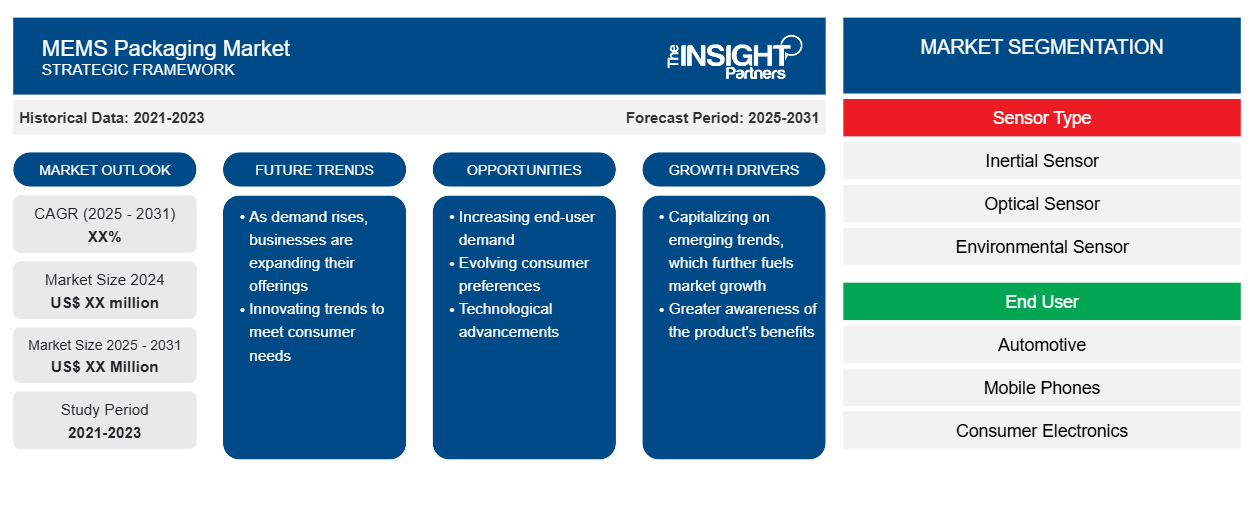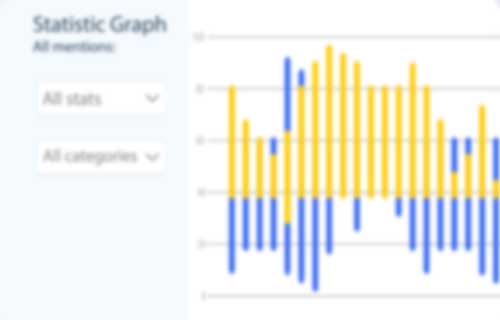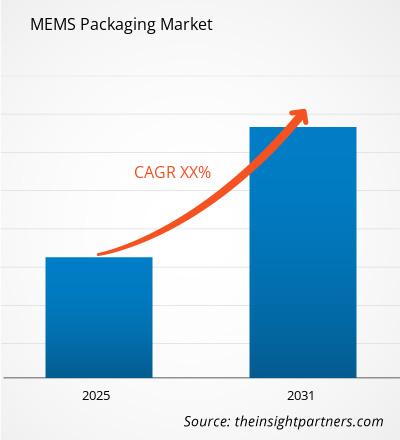[Research Report] The MEMS packaging market is expected to grow from 40.46 billion in 2022 to US$ 96.65 billion by 2031; it is projected to grow at a CAGR of 11.6% from 2022 to 2031.
MEMS Packaging Market Analyst Perspective:
Microelectromechanical systems (MEMS) advancements have historically focused on device functionality and sensitivity. However, due to the vast range of device dimensions and packages being device-specific, the packaging of MEMS devices has become a bottleneck. Despite the fact that the MEMS packaging market is expected to grow twice as quickly as the integrated circuit (IC) packaging sector, MEMS packaging remains one of the least investigated components of MEMS technology, accounting for up to 20-40% of total material and assembly costs. One critical challenge is the cleanliness of MEMS device surfaces after packaging, as contaminants may interfere with device performance and dependability.
To address these concerns, there are several sacrificial polymer-based airgap MEMS packaging as a low-cost, clean, IC-compatible, high-volume, semi-hermetic, wafer-level packaging solution. The goal is to stabilize and secure the mobile MEMS components within a protective envelope so that the MEMS chip can be treated like an integrated circuit (IC) and benefit from low-cost, high-volume IC packaging, such as lead-frame or plastic over molding. Complete thermal decomposition of a sacrificial polymer, poly(propylene carbonate) (PPC), encapsulated with overcoat materials such as BCB (Cyclotene) and epoxy-molding compound (EMC), and permeation of PPC decomposition products through the overcoat materials, are used in the airgap creation process.
The market is quickly expanding due to the numerous benefits these devices provide, such as their tiny size, low power consumption, and great dependability. The growing desire for miniaturization is one of the primary drivers of the MEMS packaging market. MEMS devices are becoming more appealing due to their compact dimensions as electronic gadgets continue to reduce in size. With the growing popularity of wearable electronics, there is an increasing demand for even smaller and more adaptable MEMS devices.
MEMS devices are also benefiting from the growing demand for electronic system reliability and safety. With an ever-expanding spectrum of applications for MEMS, there is also an increasing demand for components that can survive harsh environments or extreme circumstances, fit into a compact form factor, and perform reliably. MEMS devices require housings for a variety of reasons, and these housings are an important component of the system since they serve as the interface between the real MEMS and the rest of the device and the rest of the world.
MEMS Packaging Market Overview:
The MEMS packaging market is anticipated to grow in demand as global demand for smart automotive solutions rises. The growing need for linked devices and consumer electronics is projected to fuel the sensor market. Furthermore, global industrial sensor Utilization is expanding due to the increasing applications of sensors, fueling demand for MEM devices. MEMS packaging has developed from packaging MEMS devices to packaging MEMS systems as MEMS device applications have grown dramatically. Innovative and efficient packaging techniques, as well as innovative packaging materials, are becoming increasingly vital.
Among the driving developments in the market is the recent technological development of CMOS-compatible MEMS manufacturing techniques for low-temperature wafer bonding and other single-chip integration. Another new development is the use of bare wafer stacks for low-cost, lead-free semiconductor packaging. This allows for the creation of low-cost, small-pin packaging for high-volume manufacture. The growing popularity of MEMS is also fueling fresh demand in the embedded die MEMS packaging market. The technology is not new to the MEMS packaging market, but its high cost and low yields have limited it to niche uses despite the enormous potential for future improvement. Advances in Bluetooth and RF modules, as well as the rise of WiFi-6, will very certainly boost investment in this technology.
The increasing popularity of MEMS devices is also prompting MEMS packaging providers to develop more novel packaging strategies to improve the efficiency and operational performance of these devices. T-SMART, a major semiconductor manufacturing business in 2021, is developing a new MEMS packaging method based on Heterogeneous Integration for the thermopile sensor. Furthermore, MEMS packaging is more difficult than IC packaging, according to IEEE, due to the diversity of MEMS devices and the need for multiple devices to be in contact with and shielded from the environment at the same time. MEMS packaging also presents issues such as die handling, die attachment, interfacial tension, and outgassing. These novel MEMS packaging problems necessitate immediate R&D activities.
Customize This Report To Suit Your Requirement
You will get customization on any report - free of charge - including parts of this report, or country-level analysis, Excel Data pack, as well as avail great offers and discounts for start-ups & universities
MEMS Packaging Market: Strategic Insights

- Get Top Key Market Trends of this report.This FREE sample will include data analysis, ranging from market trends to estimates and forecasts.
Customize This Report To Suit Your Requirement
You will get customization on any report - free of charge - including parts of this report, or country-level analysis, Excel Data pack, as well as avail great offers and discounts for start-ups & universities
MEMS Packaging Market: Strategic Insights

- Get Top Key Market Trends of this report.This FREE sample will include data analysis, ranging from market trends to estimates and forecasts.
MEMS Packaging Market Driver:
Growing Adoption of Smartphones and Connected Devices is Expected to Drive the Demand in the MEMS packaging market
Globally, the number of smartphone users is rapidly increasing. Consumers are switching to smartphones to take advantage of the various features they provide, such as connectivity, payment, gaming, photography, and GPS. Because various sensors are integrated into the hardware of smartphones to enable such functionality, the growing number of smartphone users is projected to have a beneficial impact on the researched market growth. Furthermore, MEMS technologies are reshaping the consumer electronics sector. Consumer electronics device manufacturers are transforming standard gadgets into linked ones that can be readily operated remotely via smartphones by combining the MEMS microphones and CMOS image sensors found in all smartphones and tablets.
- This FREE sample will include data analysis, ranging from market trends to estimates and forecasts.
MEMS Packaging Market Segmental Analysis:
Based on product type, the marketis segmented into sensor type and end user. The sensor type segment is further segmented as Optical Sensor, Inertial Sensor, Environmental Sensor, Ultrasonic Sensor, RF MEMS, and Others. The end user is further segmented into Automotive, Mobile Phones, Consumer Electronics, Medical Systems, Industrial, and Other. Inertial Sensors include accelerometers and gyroscopes used in devices like smartphones for motion sensing, navigation, and image stabilization. In MEMS packaging, these sensors are integrated to ensure precise measurements and reliable performance. Optical Sensors, such as ambient light sensors and proximity sensors, are employed in smartphones, cameras, and other devices. MEMS packaging optimizes their integration, maintaining accuracy and enhancing durability in various environmental conditions. Environmental Sensors MEMS packaging for environmental sensors like temperature, humidity, and pressure sensors is crucial for applications in smart homes, industrial settings, and weather monitoring. It protects the sensitive components from external factors, ensuring accurate readings. Ultrasonic Sensors Used in applications like distance measurement, object detection, and medical imaging, ultrasonic sensors benefit from MEMS packaging by providing compact, reliable, and efficient solutions. MEMS packaging enhances their performance while maintaining a small form factor. In the market, the focus is on miniaturization, reliability, and cost-effectiveness to meet the demands of diverse industries such as consumer electronics, automotive, healthcare, and industrial automation. The integration of these sensors in MEMS packaging facilitates the creation of advanced and compact devices with improved functionality. This is initiating the market.


- This FREE sample will include data analysis, ranging from market trends to estimates and forecasts.

- This FREE sample will include data analysis, ranging from market trends to estimates and forecasts.
MEMS Packaging Market Regional Analysis:
In the market, because of factors such as higher R&D capabilities, the presence of some of the largest semiconductor and tech companies such as Intel, Dell, and others, as well as higher penetration of electronic devices, IoT, and advanced automotive technologies, the North American region has traditionally been a major shareholder of the global electronics industry. For example, the region is regarded as a pioneer in the adoption of ADAS-enabled automobiles and autonomous mobility systems. According to Deutsche Bank, ADAS vehicle manufacturing in the United States was 18.45 million units in 2021.
MEMS devices are increasingly being used by automotive businesses to provide unique functionality to their vehicles. MEMS-based LiDARs, for example, were an option for autonomous/driverless automobiles, industrial robots, UAVs, and so on; in September 2021, General Motors picked Cepton to deliver MEME-based LiDAR for 2023 production. The Cepton LiDAR is intended to be used by General Motors to improve ADAS capabilities for autonomous emergency braking and pedestrian recognition, as well as to allow its future Ultra Cruise system. Companies are also focusing on developing cutting-edge sensors and getting recognition for their creative goods. For example, Unisem, a North American and global semiconductor assembly and test services supplier, won the Packaging Process Showdown at the MEMS and SENSORS Technical Congress (MSTC) in April 2022 for its presentation, MEMS Cavity.
MEMS Packaging Market Key Player Analysis:
The MEMS packaging market analysis consists of the players such as AAC Technologies, Analog Devices, Inc, Bosch Sensortec GmbH, ChipMos Technologies Inc, Infineon Technologies AG, MEMSCAP, Orbotech Ltd, Texas Instruments Incorporated, Taiwan Semiconductor Manufacturing Company Limited, TDK Corporation, are among the players in the market.
MEMS Packaging Market Recent Developments:
Inorganic and organic strategies such as mergers and acquisitions are highly accepted by companies in the market. A few recent key market developments are listed below:
- In August 2022, MEMSIC, a MEMS technology solution provider, released the first MEMS 6-axis inertial sensor (IMU) MIC6100AL. The product integrates a 3-axis gyroscope and 3-axis accelerometer, which can support motion sensing interactive systems such as game controllers and smart remote controls, with sensitive sensing and greatly enhancing user experience. MEMSIC has a strong algorithm team to provide users with algorithm support, which can meet the needs of rich application scenarios.
- In February 2022, STMicroelectronics introduced its third generation of MEMS sensors. The new sensors enable the next leap in performance and features for consumer mobiles and smart industries, healthcare, and retail.
- In May 2023, Horizon Microtechnologies created a template-based 3D microfabrication method that adds functionality to plastic micro-AM parts and has potential in microelectrical-mechanical systems (MEMS) packaging.
- In April 2022, Unisem, one of the global providers of semiconductor assembly and test services, won the Packaging Process Showdown at MEMS & Sensors Technical Congress (MSTC) for its presentation MEMS Cavity Packages —The Applications, Options and Considerations. More than 100 conference attendees chose Unisem gathered April 26-27 at the David Brower Center in Berkeley, California, for insights into the latest MEMS and sensors trends and innovations. SEMI MEMS & Sensors Industry Group (MSIG) stages the event.
MEMS Packaging Report Scope
| Report Attribute | Details |
|---|---|
| Market size in 2024 | US$ XX million |
| Market Size by 2031 | US$ XX Million |
| Global CAGR (2025 - 2031) | XX% |
| Historical Data | 2021-2023 |
| Forecast period | 2025-2031 |
| Segments Covered |
By Sensor Type
|
| Regions and Countries Covered | North America
|
| Market leaders and key company profiles |
- Historical Analysis (2 Years), Base Year, Forecast (7 Years) with CAGR
- PEST and SWOT Analysis
- Market Size Value / Volume - Global, Regional, Country
- Industry and Competitive Landscape
- Excel Dataset


- Hot Melt Adhesives Market
- Health Economics and Outcome Research (HEOR) Services Market
- Automotive Fabric Market
- Airport Runway FOD Detection Systems Market
- Real-Time Location Systems Market
- Occupational Health Market
- Molecular Diagnostics Market
- Arterial Blood Gas Kits Market
- Visualization and 3D Rendering Software Market
- GNSS Chip Market

Report Coverage
Revenue forecast, Company Analysis, Industry landscape, Growth factors, and Trends

Segment Covered
This text is related
to segments covered.

Regional Scope
North America, Europe, Asia Pacific, Middle East & Africa, South & Central America

Country Scope
This text is related
to country scope.
Trends and growth analysis reports related to Electronics and Semiconductor : READ MORE..
The List of Companies
1. AAC Technologies
2. Analog Devices, Inc.
3. Bosch Sensortec GmbH
4. ChipMos Technologies Inc.
5. Infineon Technologies AG
6. MEMSCAP
7. Orbotech Ltd.
8. Texas Instruments Incorporated
9. Taiwan Semiconductor Manufacturing Company Limited
10. TDK Corporation

 Get Free Sample For
Get Free Sample For